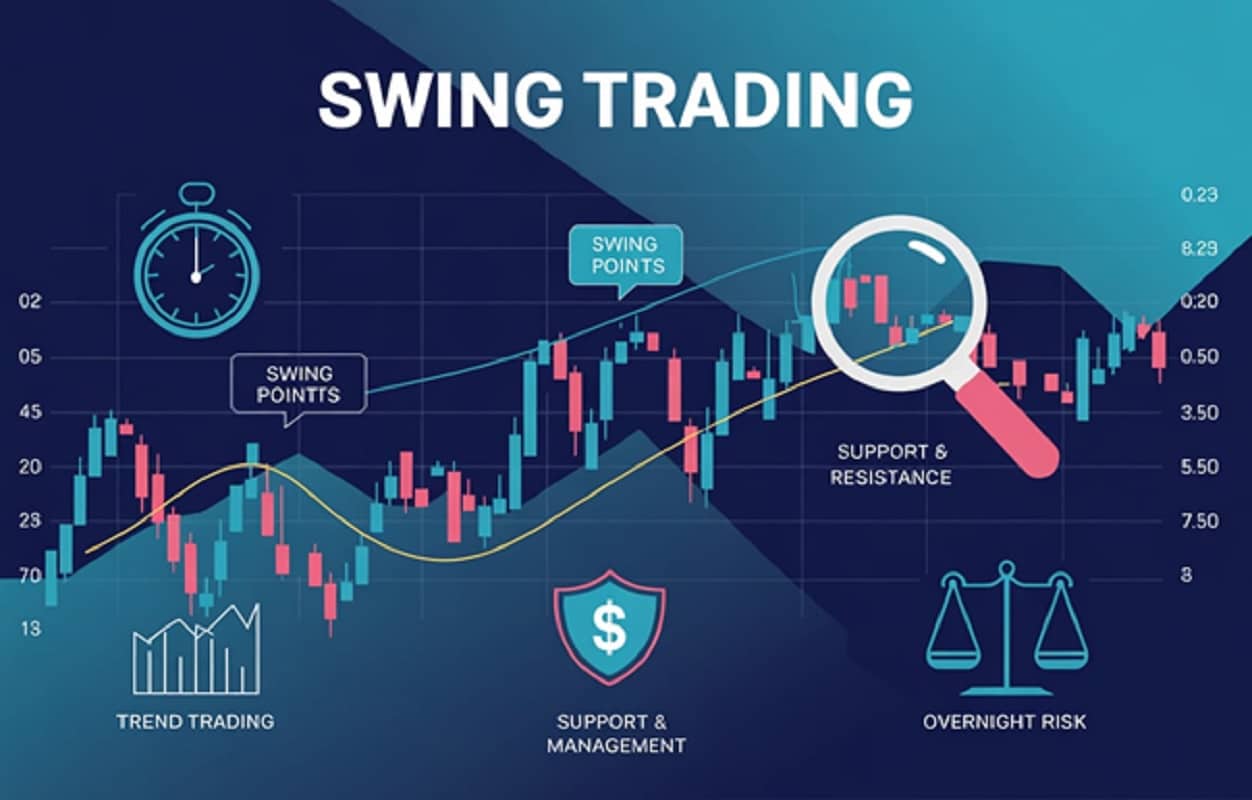Swing trading is a market strategy focused on capturing gains from price ‘swings’ over several days to several weeks. It works on the idea that markets move in waves, creating intermediate highs and lows within a larger trend. Swing traders aim to enter trades as these smaller counter-moves seem to be ending and the main trend is likely to continue, or by trading near the edges of established price ranges. The goal isn’t perfect timing but capturing a solid part of these medium-term moves. This acknowledges that perfect prediction is impossible and focuses on realistic profits within market cycles.
Sitting between the rapid pace of day trading and the long view of investing, swing trading holds a unique spot. Unlike day traders who close positions daily, swing traders hold positions overnight, sometimes for weeks, allowing trades more time to play out. This aims for potentially larger gains per trade than day trading. Yet, it’s shorter than the months or years typical of long-term investing based on company fundamentals. Swing trading requires more activity than passive investing but usually less screen time than day trading , suiting those wanting active participation without constant monitoring.
Swing Trading vs. Other Styles: Finding Your Fit
Knowing how swing trading differs from other approaches helps determine if it matches your goals, risk tolerance, and time.
Swing Trading vs. Day Trading: Key Differences
The main difference is the holding period: days to weeks for swing trading versus within a single day for day trading. This affects trade frequency and profit goals. Swing traders make fewer trades, aiming for bigger price moves. Day traders make many small trades for frequent, smaller gains.
Time commitment also differs. Day trading often needs full-time focus. Swing trading can often be managed part-time. Both use technical analysis, but swing traders might take a slightly broader view , while day traders focus on immediate signals.
Risk exposure varies. Swing traders face overnight risk—the danger of bad news hitting when markets are closed. Day traders avoid this by closing positions daily. Swing trading also bypasses the US Pattern Day Trader (PDT) rule, which requires $25,000 minimum equity for frequent day traders, making it more accessible for those starting with less capital.
Swing Trading vs. Long-Term Investing: Contrasting Philosophies
The contrast here is stark. Holding periods are days/weeks versus months/years. Swing traders seek profit from volatility , while investors look for returns from company growth and value over time.
Their analysis focus differs too. Swing trading leans heavily on technical analysis (charts, patterns, indicators) , while long-term investing uses fundamental analysis (company health, financials). Relying on technicals might seem simpler by narrowing research scope, but it requires mastering chart interpretation.
Activity levels are distinct. Swing trading is active, needing regular management. Investing is often passive (“buy and hold”). Risk focus also varies: swing traders manage short-term volatility , while investors focus on company and long-term market risks.
Trading Styles Overview
|
Feature |
Day Trading |
Swing Trading |
Long-Term Investing |
| Typical Holding Period | Minutes to Hours (Intraday) | Days to Weeks | Months to Years |
| Primary Analysis | Technical | Primarily Technical | Primarily Fundamental |
| Goal | Profit from small intraday moves | Profit from short-to-medium term swings | Profit from growth, dividends, value |
| Trade Frequency | High (Multiple trades per day) | Moderate (Several trades per week/month) | Low (Few trades per year) |
| Time Commitment | High (Often full-time) | Moderate (Can be part-time) | Low (Minimal ongoing monitoring) |
| Key Risk Factor | High intraday volatility, execution | Overnight/Weekend gaps, sharp reversals | Company performance, long-term market risk |
| Capital Requirements | Potentially high (PDT rule applies) | Moderate (Avoids PDT rule) | Variable, depends on strategy |
The Swing Trader’s Toolkit: Essential Concepts
Effective swing trading relies on using technical analysis to read the market and spot opportunities.
Why Technical Analysis is Crucial
Technical analysis uses past market data, mainly price and volume, to find patterns suggesting future direction. For swing traders aiming for moves over days or weeks, it provides vital timing tools. Company fundamentals often change too slowly for this timeframe. Thus, traders depend on charts, patterns, and price action.
Reading the Charts: Price Action Basics
Understanding price charts is key. Candlestick charts are popular, showing the open, high, low, and close prices for a period, offering sentiment clues. Analyzing these patterns (‘price action’) is the core of technical analysis. Grasping price behavior at key levels is crucial before adding indicators.
Understanding Market Trends: Up, Down, and Sideways
Markets generally trend in three ways:
- Uptrend: Higher highs and higher lows. Buyers are in control.
- Downtrend: Lower highs and lower lows. Sellers dominate.
- Sideways Trend (Range): Price moves horizontally between support and resistance. Buyers and sellers are balanced.
Trend lines help visualize trends. An uptrend line connects rising lows (support); a downtrend line connects falling highs (resistance). A common principle, especially for novices, is trading with the trend (“the trend is your friend”). This focuses on higher-probability setups aligned with market momentum.
Support and Resistance: The Market’s Floors and Ceilings
These are key price areas where supply and demand tend to shift.
- Support: A level where falling prices often stop and may reverse up. Buyers step in, seeing value.
- Resistance: A level where rising prices often stall and may turn down. Sellers take control or profits.
These levels are found by looking at past price reversals or consolidations. Think of them as zones, not exact lines. Price might briefly poke through without breaking the zone.
A key concept is role reversal: broken resistance often becomes new support, and broken support often becomes new resistance. This helps understand market structure and find entry/exit points. Identifying these zones is vital for setting entries, targets, and stop-losses. However, confirmation (like a clear bounce or confirming pattern ) is often needed before trading, as levels can break.

Popular Swing Trading Strategies for Novices
These frameworks help identify entries and exits using technical analysis.
Trading with the Trend: Buying Dips and Selling Rallies
Aligning with the dominant trend is often best for beginners.
- Uptrend (“Buying the Dip”): Identify uptrend. Wait for pullback to support (prior low, trend line, MA). Look for confirmation (bounce, bullish pattern , RSI turn ). Enter long. Stop-loss below support. Target near prior high/resistance.
- Downtrend (“Selling the Rally”): Identify downtrend. Wait for rally to resistance. Look for confirmation (rejection, bearish pattern, RSI turn ). Enter short. Stop-loss above resistance. Target near prior low/support.
Range-Bound Trading: Capitalizing on Bounces
Used when price moves sideways between clear support and resistance.
- Strategy: Identify range. Near support, look for bounce confirmation, then buy. Near resistance, look for rejection confirmation, then sell/exit long. Stops just outside the range. Targets near the opposite boundary.
Breakout Trading: Entering on Momentum Shifts
Aims to catch the start of a new trend as price breaks a key level or pattern.
- Approaches:
- Aggressive: Enter immediately on the break. Riskier due to potential “false breakouts”. High volume confirms.
- Conservative: Wait for break, then a pullback to retest the broken level. Enter if the level holds (role reversal ). Safer, but might miss the move.
- Risk Management: Stops placed back inside the broken level/pattern. Targets sometimes estimated by pattern height.
Choosing the right strategy depends on correctly identifying the market condition (trending/ranging). Applying the wrong strategy is a common error.
Choosing What to Trade: Selecting Suitable Stocks/Assets
Not all assets suit swing trading. Volatility and liquidity are key factors.
The Role of Volatility and Liquidity
- Volatility: Need enough price movement for ‘swings’. Too little offers no opportunity; too much increases risk. Moderate, predictable volatility is often best.
- Liquidity: Ease of buying/selling without affecting price. High volume and tight bid-ask spreads are crucial. Ensures easy entry/exit near desired prices. Illiquid stocks are hard and costly to trade.
Focus on actively traded stocks and ETFs with swing potential. Large-caps or major ETFs often balance volatility and liquidity. Maintain a watchlist to learn asset behavior. Novices might start with more liquid, less volatile assets until skills develop.
Managing Risk: The Cornerstone of Swing Trading Success
Rigorous risk management is crucial, especially with overnight exposure.
The Non-Negotiable Stop-Loss Order
An order to automatically sell if price hits a predetermined level, limiting losses. Essential for swing traders facing overnight risk. Place stops logically—where the trade idea is invalidated (e.g., below support for longs, above resistance for shorts). Stops aren’t guaranteed at the exact price (‘slippage’) but are vital.
Position Sizing: Don’t Bet the Farm
Determine trade size based on account size and stop-loss distance. Risk only a small percentage (e.g., 1-2%) of capital per trade. Example: $10k account, 1% risk ($100), $1 stop distance -> trade 100 shares ($100 / $1). Ensures survival through losing streaks.
Emotional Discipline: Taming Fear and Greed
Trading triggers emotions. Success requires:
- Patience: Wait for good setups; let winners run.
- Discipline: Follow the trading plan strictly.
- Objectivity: Trade based on market action, not hope or fear. Avoid impulsive decisions.
Risk/Reward Ratio
Assess potential profit versus potential loss before trading. Aim for trades where reward is at least 2-3 times the risk (e.g., 2:1 or 3:1). Skip setups with poor risk/reward, even if technically valid. Effective risk management reduces stress and prevents catastrophic losses.
Conclusion: Key Takeaways for Aspiring Swing Traders
Swing trading offers a way to profit from medium-term market moves, blending aspects of day trading and long-term investing. It relies on technical analysis to identify trends, support/resistance, and use indicators for timing trades over days to weeks.
Success hinges not just on technical skill but critically on rigorous risk management—using stop-losses and proper position sizing—and emotional discipline to follow a plan patiently and objectively. For newcomers, a structured approach is vital: educate yourself, practice extensively with paper trading, create a detailed trading plan, and start live trading with small amounts of risk capital. Swing trading involves real risks alongside opportunities; realistic expectations, continuous learning, and a steadfast focus on managing risk are essential for navigating this challenging but potentially rewarding market approach.
Frequently Asked Questions (FAQ)
How much capital do I need to start swing trading?
There isn’t a universal minimum amount required to start swing trading, and importantly, it avoids the $25,000 Pattern Day Trader rule. However, sufficient capital is needed to cover commissions, manage risk through proper position sizing (risking only a small percentage per trade) , and absorb potential drawdowns. Brokerage account minimums may also apply. Crucially, only trade with capital you can afford to lose.
Can I swing trade part-time or with a full-time job?
Yes, many consider swing trading more compatible with a part-time schedule compared to day trading. Since positions are held over days or weeks, market analysis and trade management can often be performed outside of standard market hours. Nonetheless, it demands a regular time commitment for research, monitoring positions, and staying updated.
What are the biggest risks in swing trading?
The primary risks include overnight and weekend risk, where market gaps can cause losses exceeding the planned stop-loss level. Abrupt market reversals can lead to significant losses if stop-losses are not used or respected. Additionally, the psychological challenges of maintaining discipline, managing fear and greed, and coping with losing streaks are substantial risks to long-term success. The inherent volatility needed for swing opportunities also contributes to risk.
































